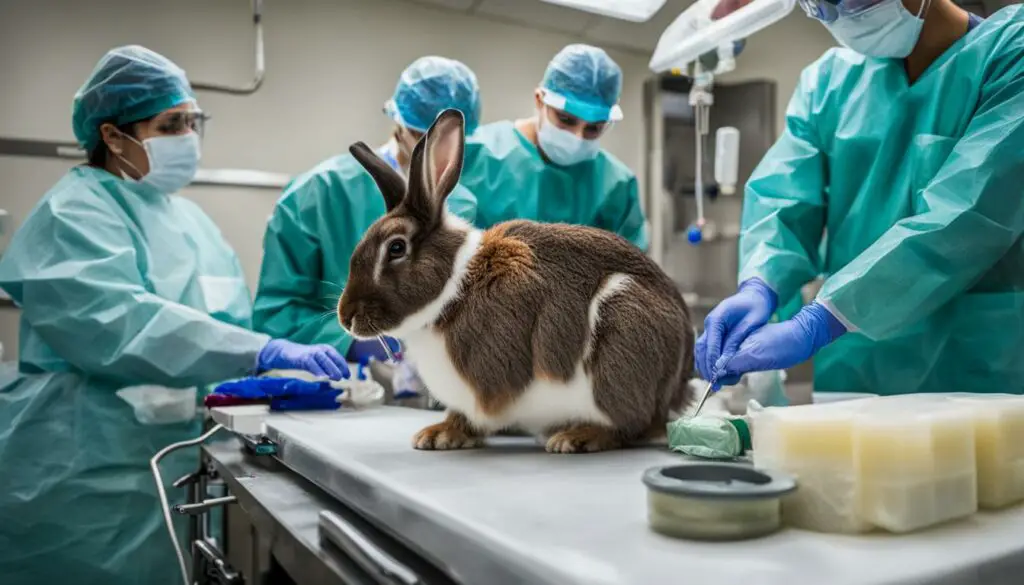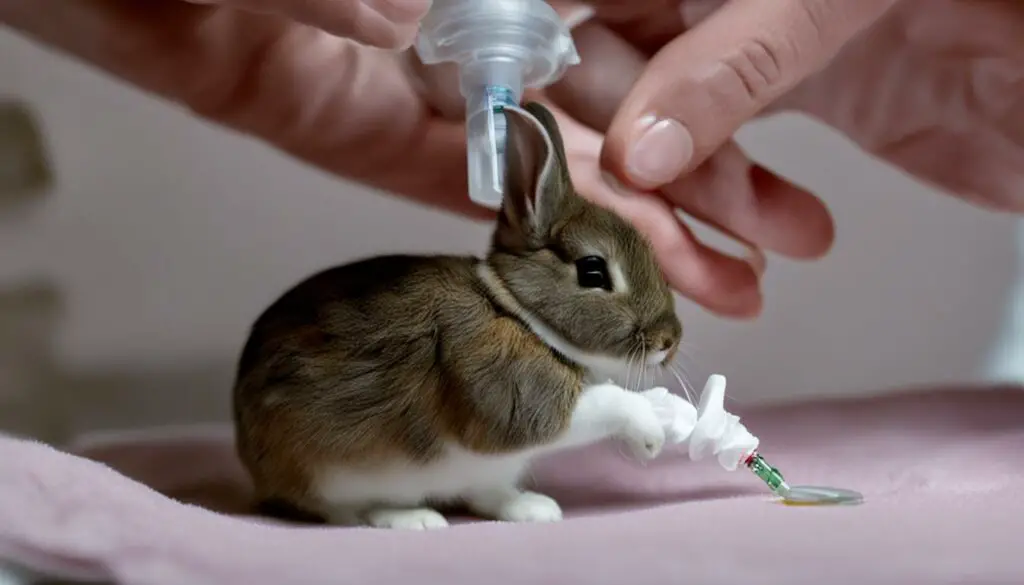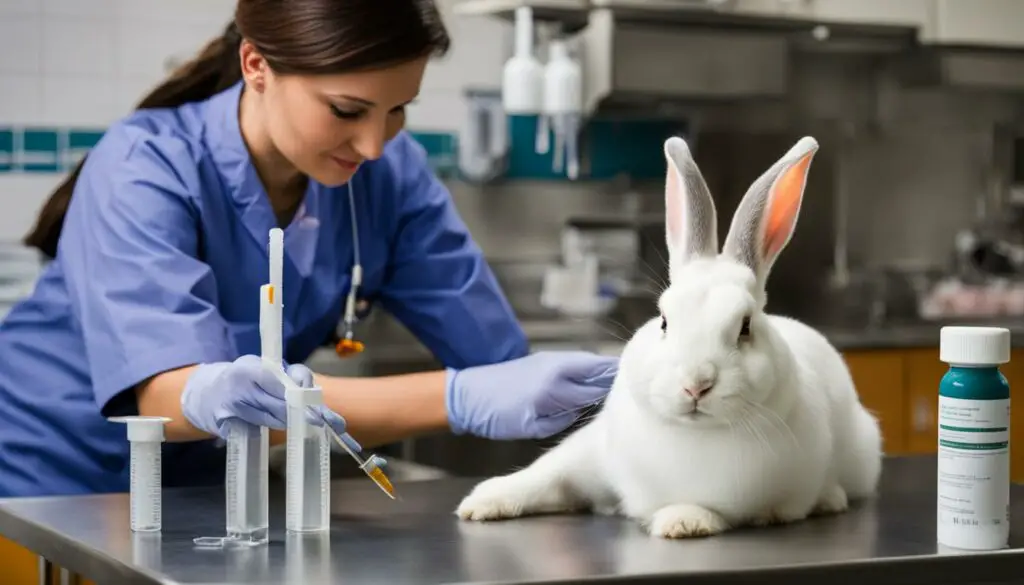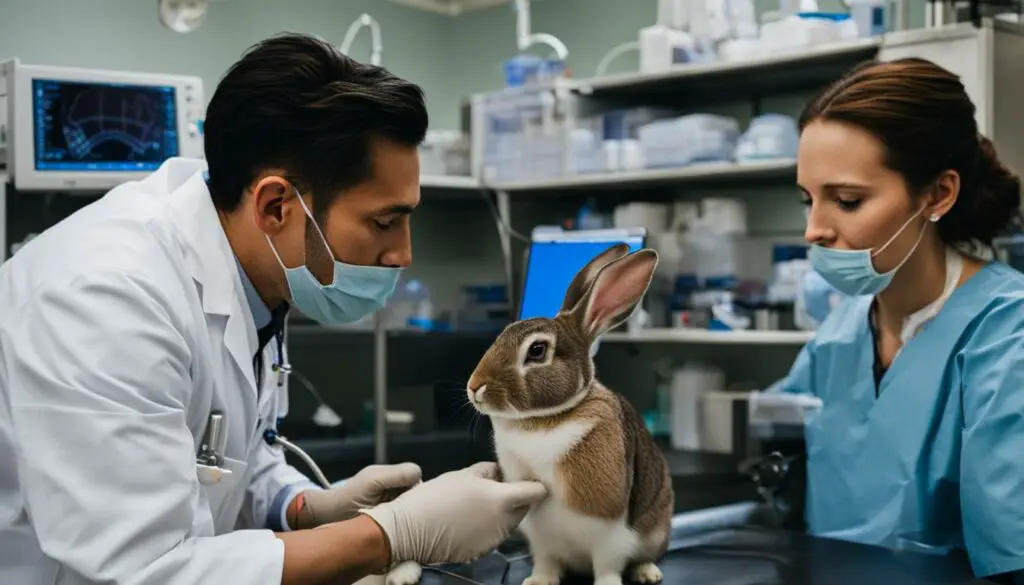Rabbits are beloved pets that bring joy and companionship to many households. However, just like any other living creature, rabbits can experience pain and discomfort. That’s where Metacam comes in. Metacam is a medication that is commonly used for pain relief in rabbits, ensuring their well-being and comfort. In this in-depth guide, we will explore the effective use of Metacam, including dosage, administration, and monitoring parameters, to help you provide the best care for your pet rabbits.
Key Takeaways:
- Metacam is a commonly used medication for pain relief in rabbits.
- Proper dosage and administration of Metacam are crucial for the well-being of rabbits.
- Monitoring vital signs is important to ensure rabbits are responding well to Metacam.
- Alternative pain management options, like meloxicam, can be considered.
- Consulting with a veterinarian is essential for determining the most suitable pain relief approach for your pet rabbits.
Guidelines for Sedation, Anesthesia, and Analgesia in Rabbits
When it comes to performing surgical procedures on rabbits, the proper administration of sedation, anesthesia, and analgesia is of utmost importance. These guidelines provided by the ULAM veterinary staff should be followed to ensure the well-being and safety of the rabbits throughout the procedures. It is crucial to prioritize the comfort and pain management of these delicate animals to ensure successful outcomes.
Guidelines for Sedation, Anesthesia, and Analgesia in Rabbits:
- Before starting any procedure, rabbits should undergo a thorough physical examination to assess their overall health and identify any pre-existing conditions that may affect their response to sedatives, anesthetics, or analgesics.
- Sedation should be used when necessary, allowing for a calm and relaxed state for the rabbitprior to anesthesia administration. This can be achieved through the use of sedative drugs, such as midazolam or acepromazine, administered intramuscularly.
- Anesthesia should be induced using an appropriate agent based on the procedure being performed and the rabbit’s health status. Commonly used anesthesia agents for rabbits include isoflurane and sevoflurane, which can be administered via a mask or endotracheal tube.
- Analgesia, or pain management, is of utmost importance during and after surgical procedures. Nonsteroidal anti-inflammatory drugs (NSAIDs) like meloxicam or Metacam can be used to provide pain relief and reduce inflammation in rabbits. The dosage should be carefully calculated based on the rabbit’s weight and approved by a veterinarian.
- Throughout the procedure, continuous monitoring of vital signs, including heart rate, respiratory rate, blood pressure, and temperature, is essential to ensure the rabbit’s well-being. Additionally, monitoring should include oxygen saturation and end-tidal carbon dioxide levels.
- Proper handling and positioning of the rabbit during anesthesia administration and the procedure itself should be ensured to minimize stress and the risk of complications. Maintaining a quiet and calm environment is crucial for the rabbit’s comfort.
Following these guidelines for sedation, anesthesia, and analgesia in rabbits is vital to ensure their safety, minimize stress, and promote optimal surgical outcomes. The welfare of these delicate animals should always be the top priority, and consulting with a veterinarian experienced in rabbit care is essential for proper administration and management of sedation, anesthesia, and analgesia.

Importance of Responsible Use of Anesthesia and Analgesia
As caring rabbit owners, it is crucial to understand the importance of responsible use of anesthesia and analgesia when it comes to the well-being of our furry friends. Anesthesia and analgesia are vital components of pain management for rabbits undergoing painful procedures, such as surgery or invasive medical treatments. It is the responsibility of the principal investigator, under the guidance of a veterinarian, to ensure that appropriate anesthesia and analgesia protocols are followed for the welfare of the rabbits.

Obtaining proper approval and adhering to approved drug protocols are essential steps to ensure the responsible use of anesthesia and analgesia in rabbits. This includes dosing the medications correctly, considering the rabbit’s individual needs, and closely monitoring their response to the treatment. By doing so, we can help minimize any potential pain or discomfort experienced by rabbits during and after procedures, promoting their overall well-being and recovery.
In addition to following approved drug protocols, it is crucial to maintain open communication with the veterinarian and seek their guidance in pain management for rabbits. They can provide valuable insights and recommendations based on their expertise and experience. By working together, we can ensure that our rabbits receive the best possible care and support during procedures that may cause pain or discomfort.
Laslo’s Experience: A Rabbit in Safe Hands
“When my rabbit, Laslo, needed to undergo dental surgery, I was understandably anxious about his well-being. However, I felt reassured when the veterinarian explained the comprehensive anesthesia and analgesia plan they had designed for him. They took into account Laslo’s specific condition, ensuring he received the appropriate medications to manage his pain and provide a smooth recovery.”
- Responsible use of anesthesia and analgesia can minimize pain and discomfort during procedures.
- Proper approval and adherence to approved drug protocols are essential.
- Consultation with a veterinarian is crucial for guidance in pain management for rabbits.
| Key Points to Remember |
|---|
| Follow approved drug protocols for anesthesia and analgesia in rabbits. |
| Communicate with the veterinarian to ensure individualized pain management for rabbits. |
| Monitor the rabbit’s response to treatment and make adjustments if necessary. |
| Responsible use of anesthesia and analgesia promotes the well-being of rabbits. |
Routes of Administration for Metacam
When it comes to administering Metacam to rabbits, there are several routes that can be used, each with its own advantages and considerations. The most common routes of administration for Metacam in rabbits include oral, intramuscular, intravenous, and subcutaneous. The choice of route depends on factors such as the specific needs of the rabbit, ease of administration, and the desired rate of absorption.
Oral administration is often the preferred route for rabbits as it is convenient and well-tolerated. Metacam can be mixed with food or water, making it easier to administer to rabbits who are resistant to taking medication directly. However, it may take longer for the medication to take effect through oral administration compared to other routes.
Intramuscular administration involves injecting Metacam into the muscle tissue. This route provides a relatively rapid absorption of the medication and may be useful in situations where quick pain relief is required. However, it can be challenging to administer properly, especially for inexperienced individuals.
Table: Comparison of Routes of Administration for Metacam in Rabbits
| Route | Advantages | Considerations |
|---|---|---|
| Oral | Convenient and well-tolerated | May take longer for effect |
| Intramuscular | Rapid absorption | Challenging to administer |
| Intravenous | Immediate effect | Requires professional expertise |
| Subcutaneous | Relatively easy to administer | Slower absorption compared to other routes |
Intravenous administration provides immediate effect as it delivers the medication directly into the bloodstream. However, this route should only be performed by professionals with experience in intravenous injections to avoid complications.
Subcutaneous administration involves injecting Metacam into the layer of tissue just beneath the skin. It is relatively easy to administer and is commonly used in rabbits. However, absorption can be slower compared to other routes, which may affect the onset of pain relief.
It is important to consult with a veterinarian to determine the most appropriate route of administration for your rabbit’s specific needs. They can provide guidance and ensure that the medication is administered correctly to optimize its effectiveness.

Normal Monitoring Parameters for Rabbits on Metacam
When administering Metacam to rabbits, it is crucial to monitor their vital signs to ensure they are responding well to the medication and to detect any potential side effects. The following table outlines the normal monitoring parameters for rabbits on Metacam:
| Vital Sign | Normal Range |
|---|---|
| Temperature | 38.5°C – 40.0°C |
| Heart Rate | 180 – 325 beats per minute |
| Respiratory Rate | 30 – 60 breaths per minute |
| Mucous Membrane Color | Pale pink |
It is important to use a reliable digital thermometer to measure the rabbit’s temperature. The heart rate can be measured by gently palpating the chest or by using a stethoscope. Respiratory rate can be observed by counting the number of breaths per minute. Checking the color of the rabbit’s mucous membranes, such as the gums, can provide valuable information about their blood circulation and oxygenation levels.
In addition to these vital signs, it is essential to monitor the rabbit for any adverse effects or changes in behavior. These may include lethargy, loss of appetite, diarrhea, or any signs of pain or discomfort. If any concerning symptoms occur, it is crucial to consult a veterinarian promptly.
Remember, regular monitoring of the vital signs and overall well-being of rabbits on Metacam is vital to ensure their comfort and safety during the administration of the medication.
Physiologic Support for Rabbits on Metacam
When rabbits are being treated with Metacam for pain relief, they may require additional physiologic support to ensure their overall health and well-being. This can include the administration of fluids or other medications as necessary.
Fluid therapy is an important aspect of physiologic support for rabbits on Metacam. It helps to maintain hydration and prevent dehydration, especially if the rabbit is experiencing decreased appetite or is unable to eat or drink normally. The administration of fluids can be done subcutaneously or intravenously, depending on the severity of the rabbit’s condition and the veterinarian’s recommendation.
In some cases, alternative pain management options may be considered for rabbits on Metacam. While Metacam is generally safe and effective for rabbits, there may be situations where it is not the most suitable option. These alternatives can include other nonsteroidal anti-inflammatory drugs (NSAIDs) or analgesics that can provide pain relief without any potential side effects or contraindications for the individual rabbit.

Table: Examples of Alternative Pain Management Options for Rabbits
| Treatment Option | Description |
|---|---|
| Meloxicam | A nonsteroidal anti-inflammatory drug that can be used as an alternative to Metacam. It offers similar pain relief properties and may be better tolerated by some rabbits. |
| Buprenorphine | An opioid analgesic that can be used in rabbits for moderate to severe pain. It is often used in combination with other medications for a more comprehensive pain management approach. |
| Gabapentin | An anticonvulsant medication that can also provide pain relief in rabbits. It is sometimes used in cases where Metacam or other NSAIDs are not suitable or effective. |
It is important to consult with a veterinarian to determine the most appropriate physiologic support and pain management options for rabbits on Metacam. The veterinarian will consider the individual rabbit’s condition, any underlying health issues, and the potential risks and benefits of each treatment option. By providing the right support and medication, we can ensure that rabbits on Metacam receive the best care and pain relief possible.
Recovery after Administration of Metacam
After the administration of Metacam, it is crucial to ensure the proper recovery of your rabbit. Creating a comfortable and safe environment is essential for their well-being during this period. Keep in mind that every rabbit’s recovery process may vary based on individual factors such as age, overall health, and the specific procedure they underwent.
During the recovery period, closely monitor your rabbit for any signs of discomfort or side effects. Observe their behavior, appetite, and overall activity level. It is normal for rabbits to have decreased appetite or be less active immediately after a procedure or while on pain medication. However, if you notice any significant changes or concerns, contact your veterinarian for guidance.
Quote: “Proper post-procedural care and recovery are crucial for the well-being of rabbits. Providing a quiet and stress-free environment can help ensure a smooth recovery process.” – Dr. Emily Johnson, Veterinarian
Additionally, it is important to consider the cost of Metacam when planning for your rabbit’s healthcare expenses. The price of Metacam can vary based on factors such as the dosage required, the duration of treatment, and the specific veterinary clinic or supplier. It is recommended to consult with your veterinarian to get an estimate of the cost and explore any alternative pain management options that may be more budget-friendly without compromising your rabbit’s well-being.

Remember, the recovery phase is a crucial part of your rabbit’s overall healing process. By providing a comfortable environment, closely monitoring their condition, and considering the cost of their medication, you can ensure that your rabbit receives the necessary care for a smooth recovery and a healthy future.
Sedation Protocols for Rabbit Procedures
In order to ensure the safety and comfort of rabbits during various procedures, sedation protocols are used. These protocols involve the administration of medications to help relax the rabbit and minimize any potential stress or discomfort. Different sedation protocols may be recommended depending on the specific procedure being performed and the individual needs of the rabbit.
When determining the appropriate sedation protocol for a rabbit, it is important to consider factors such as the rabbit’s age, health status, and temperament. Additionally, the type and duration of the procedure should be taken into account. It is crucial to work closely with a veterinarian to determine the most suitable sedation protocol for each individual case.
Commonly used sedative medications for rabbits include:
- Diazepam (Valium): A medication that provides muscle relaxation and sedation.
- Midazolam (Versed): A short-acting sedative that helps promote relaxation.
- Ketamine: An anesthetic medication that can be used in combination with other sedatives.
These medications can be administered via different routes, such as intramuscular or intravenous injection. The dosage and administration technique will depend on the specific medication and the unique needs of the rabbit.
| Sedative Medication | Route of Administration | Dosage |
|---|---|---|
| Diazepam | Intramuscular or intravenous | 0.2-0.5 mg/kg |
| Midazolam | Intramuscular or intravenous | 0.5-1 mg/kg |
| Ketamine | Intramuscular or intravenous | 5-15 mg/kg |
It is crucial to closely monitor the rabbit’s vital signs and response to sedation during the procedure. This includes monitoring heart rate, respiratory rate, and temperature. The rabbit should be kept in a calm and quiet environment to minimize stress. After the procedure, appropriate recovery protocols should be followed to ensure a smooth transition back to full consciousness.

Anesthetic Protocols for Rabbit Procedures
When performing procedures on rabbits, it is crucial to establish appropriate anesthetic protocols to ensure the safety and comfort of these delicate animals. Anesthesia plays a vital role in minimizing pain and stress during surgical interventions or other invasive procedures. Nonsteroidal anti-inflammatory drugs (NSAIDs), such as Metacam, are commonly included in these protocols to help manage pain before, during, and after the procedure.

One commonly used anesthetic protocol for rabbits involves the administration of a combination of injectable anesthetic agents and inhalant anesthesia. This approach provides a balanced anesthesia, allowing for the induction and maintenance of anesthesia while minimizing adverse effects. The specific combination of drugs used may vary depending on factors such as the type of procedure, the rabbit’s health status, and the individual veterinarian’s preference.
“Proper anesthetic protocols are vital for ensuring the safety and well-being of rabbits during procedures. By carefully tailoring the drugs and techniques to the specific needs of each rabbit, we can provide effective pain relief and minimize the risks associated with anesthesia.”
When designing an anesthetic protocol for rabbits, it is essential to consider their unique physiological characteristics. Rabbits are highly sensitive to stress, and they have a delicate respiratory system that requires careful monitoring and management during anesthesia. Additionally, their relatively small size and specific drug metabolism necessitate precise dosing calculations to avoid overdose or inadequate anesthesia.
Risks and Considerations
Although anesthetic protocols for rabbits have improved significantly in recent years, there are still risks associated with anesthesia, including respiratory depression, hypothermia, and cardiovascular instability. Therefore, close monitoring throughout the procedure is essential to detect and address any potential complications promptly. Proper preoperative evaluation, including a thorough medical history and physical examination, can help identify any underlying conditions that may increase the risks associated with anesthesia.
Overall, anesthetic protocols for rabbits should be developed and implemented with great care, taking into account the individual needs and characteristics of each rabbit. By following established guidelines and considering the latest research and best practices, veterinary professionals can provide optimal pain management and ensure the highest standard of care for rabbits undergoing procedures.
Table
| Anesthetic Agent | Dosage | Route of administration |
|---|---|---|
| Isoflurane | 2-5% for induction | Inhalation |
| Sevoflurane | 2-5% for induction | Inhalation |
| Ketamine/Xylazine | Ketamine: 15-20 mg/kg Xylazine: 2-5 mg/kg |
Injection |
Neuromuscular Blocking Agents for Rabbit Procedures
Rabbits undergoing certain procedures may require the use of neuromuscular blocking agents to induce muscle relaxation. These agents are carefully administered to ensure the safety and comfort of the rabbit during the procedure. It is important to follow appropriate dosage charts and guidelines to prevent any adverse effects on the rabbit’s health.
Neuromuscular blocking agents work by blocking the transmission of signals from nerves to muscles, resulting in temporary paralysis. This allows veterinarians to perform procedures more effectively and reduces the risk of injury to the rabbit. However, these agents must be used with caution and under the supervision of a trained professional.
“Neuromuscular blocking agents play a crucial role in ensuring the successful completion of rabbit procedures,” says Dr. Emily Johnson, a renowned veterinarian specializing in rabbit care. “The dosage chart should be followed precisely, taking into account the rabbit’s weight and the specific procedure being performed.”
It is important to note that the use of neuromuscular blocking agents should always be combined with appropriate anesthesia and analgesia to ensure the rabbit’s comfort and well-being. By following proper protocols and guidelines, veterinarians can provide the best possible care for rabbits undergoing procedures that require the use of these agents.

| Neuromuscular Blocking Agent | Dosage Guidelines |
|---|---|
| Atracurium | 0.4-0.6 mg/kg intravenously |
| Vecuronium | 0.1-0.2 mg/kg intravenously |
| Rocuronium | 0.6-1.2 mg/kg intravenously |
Table: Dosage guidelines for common neuromuscular blocking agents used in rabbit procedures.
Local Anesthetics for Rabbit Procedures
When it comes to performing certain procedures on rabbits, local anesthetics can play a crucial role in ensuring the comfort and well-being of these animals. Local anesthetics are medications that are administered to induce temporary loss of sensation in specific areas of the rabbit’s body, allowing veterinarians to perform procedures without causing pain or discomfort.
One commonly used local anesthetic for rabbits is lidocaine. Lidocaine works by blocking nerve signals in the area where it is applied, numbing the region and preventing the rabbit from feeling pain. It is important to note that the dosage of lidocaine should be determined based on the specific procedure being performed and the rabbit’s individual needs. Consulting with a veterinarian is essential to ensure the safe and effective use of lidocaine in rabbits.

Table: Comparison of Local Anesthetics for Rabbits
| Local Anesthetic | Usage | Duration of Action | Side Effects |
|---|---|---|---|
| Lidocaine | Mainly used as a surface anesthetic | Short-acting | Minimal side effects when used appropriately |
| Bupivacaine | Used for longer duration procedures | Long-acting | Potential for systemic toxicity if used improperly |
| Mepivacaine | Used for shorter duration procedures | Intermediate-acting | Minimal side effects when used appropriately |
It is essential to select the most appropriate local anesthetic based on factors such as the duration of the procedure, the specific area to be numbed, and the potential for systemic effects. The use of local anesthetics in rabbits should always be guided by an experienced veterinarian who can determine the best course of action for the rabbit’s individual needs.
Analgesics for Rabbit Procedures
When it comes to providing pain relief for rabbits during and after procedures, analgesics play a crucial role in ensuring their comfort and well-being. One commonly used analgesic for rabbits is Metacam, which contains the active ingredient meloxicam. Metacam belongs to the class of nonsteroidal anti-inflammatory drugs (NSAIDs) and is known for its effective pain-relieving properties.
Administering the correct dosage of Metacam is essential to ensure optimal pain management for rabbits. It is important to consult with a veterinarian and follow the recommended dosage chart based on the rabbit’s weight and the severity of the pain. The dosage chart provides clear guidelines to ensure the safe and effective use of Metacam in rabbits.
It’s worth noting that there are alternative analgesics available for rabbits, and the choice of analgesic may vary depending on the specific procedure and the individual needs of the rabbit. Some other commonly used analgesics for rabbits include buprenorphine and tramadol. These analgesics work differently from Metacam and may be recommended in specific situations or for rabbits that do not respond well to NSAIDs.
“Proper pain management is crucial to ensure the well-being and speedy recovery of rabbits undergoing procedures.”
It is important to remember that analgesics alone may not be sufficient to manage pain in rabbits. Multimodal pain management, which involves the use of multiple pain-relieving strategies, is often recommended for optimal pain control. This may include a combination of analgesics, local anesthetics, and physiologic support to address different aspects of pain during and after procedures.
Overall, analgesics like Metacam play a vital role in providing pain relief for rabbits undergoing procedures. By following the recommended dosage chart and consulting with a veterinarian, you can ensure that your rabbit receives the appropriate pain management to support their recovery and overall well-being.
| Analgesic | Usage | Advantages |
|---|---|---|
| Metacam (meloxicam) | Oral administration | – Effective pain relief – Easy to administer |
| Buprenorphine | Subcutaneous or intravenous administration | – Long-acting pain relief – Suitable for rabbits that do not respond well to NSAIDs |
| Tramadol | Oral administration | – Provides additional pain relief – Can be used in combination with other analgesics |
Meloxicam as an Alternative to Opioid Administration in Rabbits
Rabbits often require pain relief medication, especially during and after surgical procedures. While opioids have traditionally been used for pain management, there is growing interest in alternative options that can provide effective pain relief with fewer side effects. One such alternative is meloxicam, a nonsteroidal anti-inflammatory drug (NSAID) commonly used in veterinary medicine.
Meloxicam has been found to be a suitable alternative to opioids for pain relief in rabbits. Studies have shown that meloxicam effectively controls postoperative pain, helping to ensure rabbits are comfortable during the recovery process. Additionally, the risk of anorexia and gastrointestinal complications associated with meloxicam use in rabbits is minimal, making it a safer choice compared to opioids.
When considering the use of meloxicam for rabbits, it is crucial to be aware of the potential side effects. Like any medication, meloxicam can have adverse effects on rabbits, including gastrointestinal disturbances and renal impairment. Therefore, it is important to follow proper dosing protocols and monitor the rabbits closely for any signs of discomfort or adverse reactions.
In summary, meloxicam offers a valuable alternative to opioid administration for pain relief in rabbits. It has been shown to be effective in controlling postoperative pain with minimal risk of anorexia and gastrointestinal complications. However, it is essential to consult with a veterinarian to determine the most suitable pain relief approach for your pet rabbits and to ensure proper dosage and monitoring to manage any potential side effects.

| Advantages of Meloxicam for Rabbits |
|---|
| Effective pain relief during the recovery period |
| Long-acting nature, reducing the frequency of administration |
| Minimal risk of anorexia and gastrointestinal complications |
| Safe alternative to opioids for pain management |
Benefits of Using Meloxicam in rabbits
When it comes to managing pain in rabbits, it is essential to explore safe and effective options. One such option is the use of meloxicam, a nonsteroidal anti-inflammatory drug (NSAID) that offers several benefits for rabbit pain management.
One of the key advantages of meloxicam is its long-acting nature. Unlike some other NSAIDs, meloxicam provides sustained pain relief, reducing the need for frequent administration. This means less stress for both rabbits and their caretakers, allowing for a more comfortable and consistent pain management approach.
Additionally, meloxicam has been shown to have fewer gastrointestinal side effects compared to other NSAIDs. This is particularly important in rabbits, as they are known to be sensitive to changes in their digestive system. By minimizing the risk of gastrointestinal complications, meloxicam provides a safer and more reliable option for pain relief in rabbits.
Furthermore, meloxicam is highly effective in providing adequate pain relief during the recovery period after procedures. The analgesic properties of meloxicam help alleviate discomfort and promote a smoother healing process. This is crucial for ensuring the overall well-being and quality of life for rabbits undergoing surgical or medical interventions.

Table: Comparison of Meloxicam and Other NSAIDs for Rabbit Pain Management
| Benefits | Meloxicam | Other NSAIDs |
|---|---|---|
| Long-acting nature | ✓ | ✗ |
| Reduced gastrointestinal side effects | ✓ | ✗ |
| Effective pain relief during recovery | ✓ | ✗ |
Table Note: A comparison highlighting the benefits of using meloxicam over other NSAIDs for rabbit pain management. Meloxicam offers a long-acting nature, reduced gastrointestinal side effects, and effective pain relief during the recovery period.
The Combination of Buprenorphine and Meloxicam for Rabbit Pain Relief
When it comes to pain management in rabbits, the combination of buprenorphine and meloxicam has shown promising results. Buprenorphine, a potent opioid analgesic, and meloxicam, a nonsteroidal anti-inflammatory drug, work together to provide effective pain relief without causing significant gastrointestinal complications. This combination can be considered as an alternative to using metacam for rabbits.
Buprenorphine is a long-acting analgesic that can provide sustained pain relief in rabbits. It acts on the central nervous system, binding to opioid receptors and reducing the perception of pain. This makes it particularly useful for postoperative pain management in rabbits. The dosage and administration of buprenorphine should be determined by a veterinarian based on the specific needs of the rabbit.
Meloxicam, on the other hand, is an NSAID that can effectively reduce inflammation and provide pain relief. It is commonly used in rabbits for its analgesic properties and minimal side effects compared to other NSAIDs. The dosage of meloxicam should also be determined by a veterinarian based on the rabbit’s weight and the severity of the pain.
The combination of buprenorphine and meloxicam offers a balanced approach to pain management in rabbits, targeting different mechanisms of pain while minimizing the risk of adverse effects. However, it is important to consult with a veterinarian to determine the most suitable pain relief approach for your pet rabbits and ensure proper dosage and administration. Every rabbit is unique, and their pain management needs may vary.

Table: Comparison of Pain Relief Options for Rabbits
| Pain Relief Options | Advantages | Disadvantages |
|---|---|---|
| Buprenorphine | Effective for postoperative pain relief, long-acting | Potential for sedation and respiratory depression |
| Meloxicam | Minimal gastrointestinal side effects, effective anti-inflammatory | Potential for renal and hepatic toxicity with prolonged use |
| Combination of Buprenorphine and Meloxicam | Effective pain relief, minimizes gastrointestinal complications | Individual dosage adjustments may be required |
Note: This table is for illustrative purposes only and should not replace veterinary advice or recommendations.
Conclusion
When it comes to providing pain relief for rabbits, Metacam is a commonly used medication that can be effective. However, it is essential to follow the proper guidelines and protocols for its administration. Monitoring the rabbits’ vital signs and ensuring a comfortable recovery period are crucial for their well-being.
It’s also important to be aware of any potential side effects of Metacam in rabbits. While it can provide pain relief, there may be risks associated with its use. Considering alternative options, such as meloxicam, can be beneficial. Meloxicam offers several advantages, including fewer gastrointestinal side effects and adequate pain relief during the recovery period.
In some cases, a combination of buprenorphine and meloxicam may be used to alleviate postoperative pain without causing significant complications. Consulting with a veterinarian is essential to determine the most suitable pain relief approach for your pet rabbits, taking into account their individual needs and any existing health conditions.
In conclusion, whether you choose Metacam or explore alternative options, the well-being and comfort of your rabbits should always be the top priority. By following proper guidelines, consulting with a veterinarian, and being attentive to any side effects, you can ensure that your rabbits receive the best pain relief possible.
FAQ
Is Metacam a commonly used medication for pain relief in rabbits?
Yes, Metacam is a commonly used medication for pain relief in rabbits. It is important to understand the proper dosage and administration of Metacam to ensure the well-being and comfort of your pet rabbits.
Are there guidelines for sedation, anesthesia, and analgesia in rabbits?
Yes, the ULAM veterinary staff has provided guidelines for sedation, anesthesia, and analgesia in laboratory rabbits. These guidelines should be followed for any surgical procedures or administration of medications.
Who is responsible for ensuring appropriate anesthesia and analgesia for rabbits undergoing painful procedures?
The principal investigator is responsible for ensuring appropriate anesthesia and analgesia for rabbits undergoing painful procedures. It is important to obtain proper approval and follow approved drug protocols to ensure the welfare of the rabbits.
What are the different routes of administration for Metacam in rabbits?
Metacam can be administered through various routes, including oral, intramuscular, intravenous, and subcutaneous. The proper route of administration should be determined based on the specific needs of the rabbit.
What vital signs should be monitored when rabbits are on Metacam?
When rabbits are on Metacam, it is important to monitor their vital signs, including temperature, heart rate, respiratory rate, and mucous membrane color. This will help ensure that they are responding well to the medication and not experiencing any adverse effects.
Do rabbits on Metacam require additional physiologic support?
Yes, rabbits on Metacam may require additional physiologic support, such as fluids or other medications, to maintain their overall health and comfort. In some cases, alternative pain management options may be considered based on the specific needs of the rabbit.
What should be done for proper recovery after the administration of Metacam?
Proper recovery protocols should be followed after the administration of Metacam to ensure the well-being of the rabbit. It is important to provide a comfortable and safe environment for the rabbit during the recovery period. Additionally, the cost of Metacam should be considered when planning for the rabbit’s healthcare expenses.
Are there specific sedation protocols for rabbit procedures?
Yes, different sedation protocols may be used for various rabbit procedures, including the use of medications like Metacam. It is important to follow proper sedation protocols and consider any reviews or recommendations for the specific procedure being performed.
Are there established anesthetic protocols for rabbit procedures?
Yes, anesthetic protocols should be established for different rabbit procedures, taking into account the specific needs and sensitivities of rabbits. Nonsteroidal anti-inflammatory drugs (NSAIDs) like Metacam may be included in these protocols to help manage pain during and after the procedure.
Can neuromuscular blocking agents be used in rabbit procedures?
Yes, in certain rabbit procedures, neuromuscular blocking agents may be used to induce muscle relaxation. These agents should be used carefully and follow appropriate dosage charts to prevent any adverse effects on the rabbit’s health.
Can local anesthetics be used in rabbit procedures?
Yes, local anesthetics may be used to temporarily induce loss of sensation in specific areas of the rabbit’s body during certain procedures. The appropriate dosage should be determined based on the specific procedure and the rabbit’s individual needs.
Can analgesics like Metacam provide pain relief for rabbits during and after procedures?
Yes, analgesics, such as Metacam, can provide pain relief for rabbits during and after procedures. The dosage of analgesics should be determined based on the rabbit’s weight, the severity of the pain, and the specific analgesic being used.
Are there alternative options to opioid medications for pain relief in rabbits?
Yes, meloxicam, a nonsteroidal anti-inflammatory drug, can be used as an alternative to opioid medications for pain relief in rabbits. It has been shown to be effective in controlling postoperative pain with minimal risk of anorexia and gastrointestinal complications.
What benefits does meloxicam offer as an analgesic for rabbits?
Meloxicam offers several benefits as an analgesic for rabbits, including its long-acting nature, fewer gastrointestinal side effects compared to other NSAIDs, and its ability to provide adequate pain relief during the recovery period.
Can the combination of buprenorphine and meloxicam alleviate postoperative pain in rabbits?
Yes, the combination of buprenorphine and meloxicam has been found to alleviate postoperative pain in rabbits without causing significant gastrointestinal complications. This combination can be considered an effective option for pain management in rabbits.
Should Metacam be the only consideration for pain relief in rabbits?
No, while Metacam is a commonly used medication for pain relief in rabbits, alternative options like meloxicam can also be considered to provide effective pain management with minimal side effects. Consulting with a veterinarian is essential to determine the most suitable pain relief approach for your pet rabbits.








